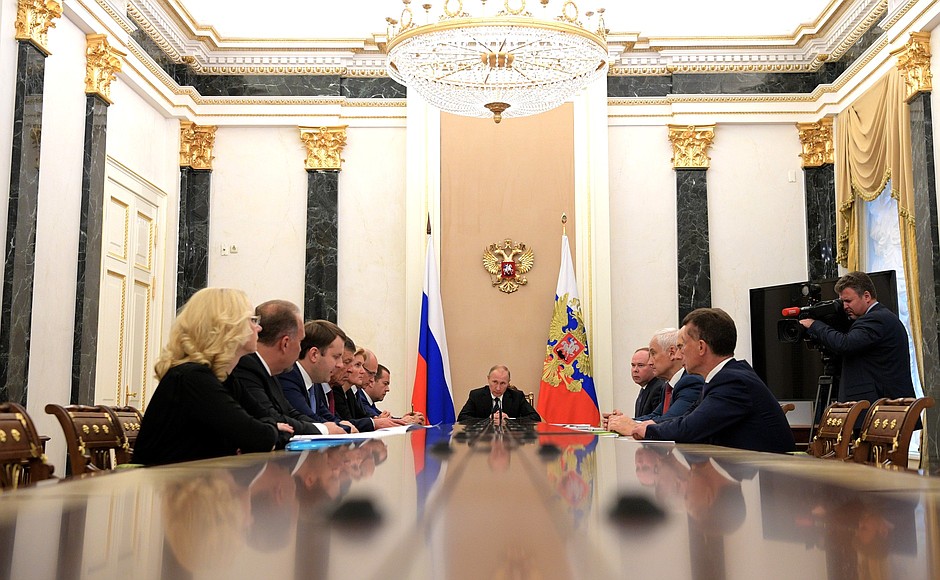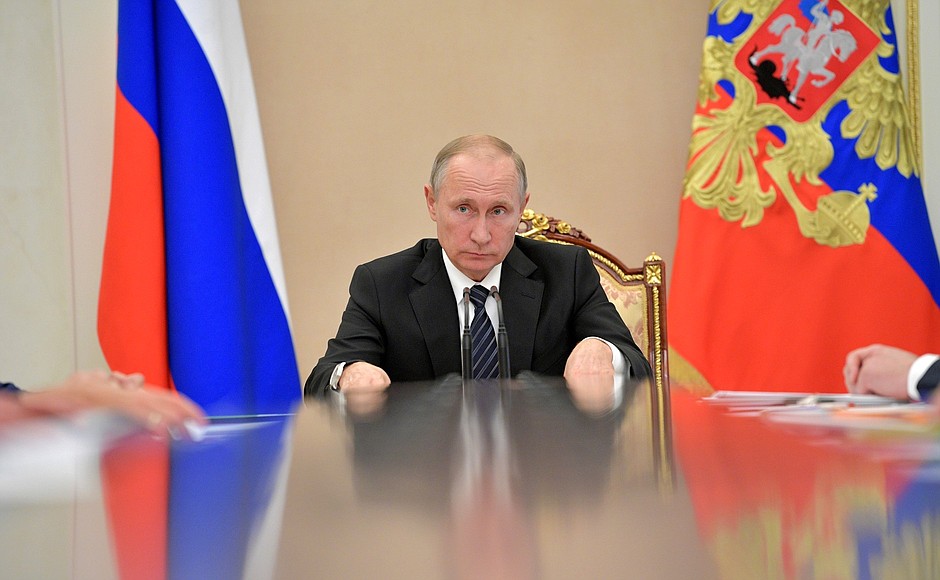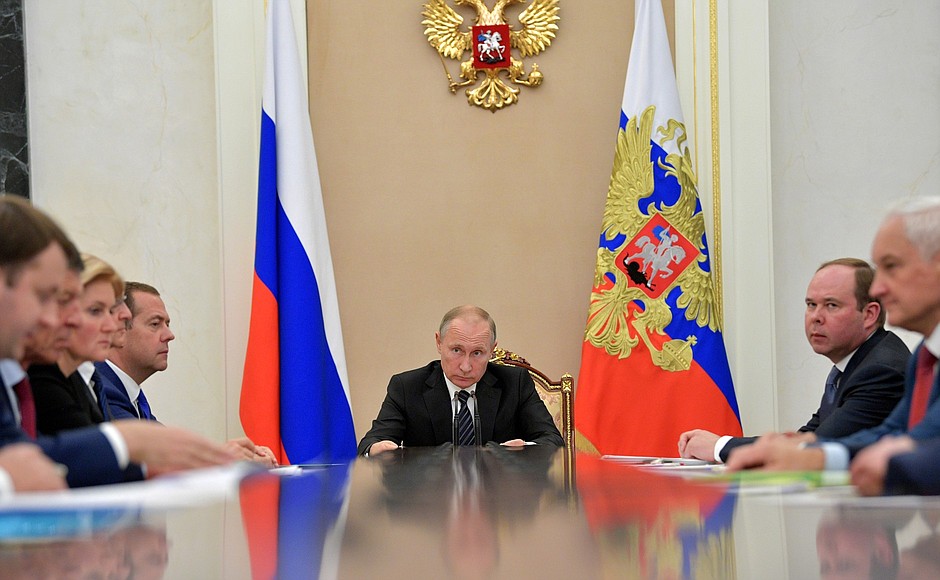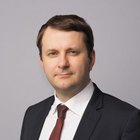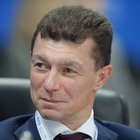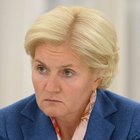President of Russia Vladimir Putin: Good afternoon, colleagues,
Today we have several issues on our agenda, including the current economic situation and forecasts to 2020.
Let us begin by listening to the Economic Development Minister. Go ahead, please.
Economic Development Minister Maxim Oreshkin: Mr President, colleagues,
Actually, we had several not very good years economically, which explains a somewhat pessimistic view of our economy. At the beginning of the year, experts did not expect GDP to grow by more than 1 percent. We can say with confidence now that these pessimistic forecasts have not materialised. We [at the Ministry] believed early this year that the economy would grow by over 2 percent and that inflation would fall below the 4 percent target. The current dynamics show that our assessments were a bit pessimistic as well.
Economic growth accelerated in the second quarter to 2.5 percent, while inflation was 3.2 percent at the beginning of last week.
Investment activity was even higher than we expected: according to available data, it reached 6.3 percent at the end of the second quarter. It is very positive news, because investment projects that are implemented today will boost economic growth tomorrow.
Following a minor technical slowdown in July, we expect a new wave of positive news and accelerated economic growth in the next few months.
What is the reason for this? First and foremost, we are entering a long cycle of lending activity in the banking sector. Inflation has stabilised at a low level, and the debt burden on people and companies has decreased over the past few years. Taken together, this created the grounds for a lending cycle that will last many years. When the inflation rate went down to 3.2 percent, it was a signal for the Bank of Russia to reduce interest rates. The goal is, as you know, to maintain inflation at around 4 percent. The Bank of Russia has announced its plans to reduce the interest rate at its meeting on Friday.
If we look at what happened within the banking system over a period of the past month, we will see that our largest banks dramatically reduced mortgage rates. They have cut the basic rate to less than 10 percent, which has increased housing affordability in Russian cities to the highest level so far. In this situation, we expect a record high volume of mortgage contracts this autumn and winter. This will bolster the construction industry and the production of construction materials in the sectors that have idling capacities.
Retail lending is gathering momentum. The important feature that distinguishes the current cycle from the previous one is that our banks are focusing on low-risk lending products, for example, those that are connected to payroll programmes. Therefore, we can expect sustainable dynamics here too.
And lastly, corporate lending. Dynamics in this sector have reached positive figures as well, which is propping up the investment activity.
Secondly, we expect the consumer demand to resurge. In addition to the reviving lending activity, which I have mentioned, salaries have started growing as well. This year alone, real wages can grow by over 3 percent, and next year we expect them to grow by some 4 percent, including due to rising wages in the public sector.
Of course, we will need several years to make up for people’s losses in 2014 and 2015, but the crucial thing is that this nascent income growth is not based on oil prices but on the active growth of labour efficiency. We expect it to grow 2 percent; last year we only reported a symbolic growth of 0.1 percent.
Considering the record low unemployment level, which we expect to drop to 4.7 percent in three years, as well as the unfavourable demography, the growth of labour efficiency will be our key to maintaining economic growth and individual incomes.
The third target is the further growth of investment activity. In this context, we must continue working to make conditions for Russian business more predictable. We are moving towards this goal thanks to changes in the macroeconomic policy, which we introduced in the past few years. These include inflation targeting by the Bank of Russia, which has helped us reduce inflation to a record low, a responsible budget policy and the introduction of a new mechanism for moderating the influence of oil prices on the national economy.
It is important that predictability is also growing at the micro level. We have launched a reform of the regulatory system, which is becoming more predictable and, most importantly, is focused on prevention rather than penalty.
Mr President, the decisions you made public at a recent meeting at the Nizhne-Bureiskaya HPP are a major element for reducing administrative pressure.
Another major component of predictability is tariff regulation. This year we continued our indexation policy that includes adjusting prices to inflation targeting. We will soon prepare proposals for transitioning to long-term price formation, so that infrastructure companies and business in general will know that prices will not change for a maximally long period of time. This issue was also discussed at a meeting in Vladivostok.
An important task in the context of the economic policy is active support of tools for investment financing. We have support programmes that are actively developing, primarily investment lending programmes. The programme Six and a Half is in effect for small and medium-sized businesses. Work is underway to launch the “factory of project financing,” which will support projects worth three billion rubles and up.
I would like to particularly thank the Bank of Russia, which has actively supported this programme’s development. Lower reserve and capital requirements will be applied to banks for the loans issued under this programme. The first loans are expected to be granted in the first quarter of 2018.
It is very important that we have organised the work under both programmes in such a way that allows for adopting a decision on granting a loan without any officials involved.
Of course, an important element for the growth of investment activity is a programme for infrastructure mortgages. I will brief you on its preparation soon. As a result of these programmes and their outcome, we expect active investment growth at 5–6 percent per year during the forecasted period.
It is clear that economic growth largely depends on the Government’s priority projects. As regards the maximum effect on GDP growth, I would like to note a project for creating conditions for active growth of non-resource exports, as well as a recently approved project for increasing labour efficiency. Under the latter, we aim for active cooperation with our Japanese partners, with a corresponding agreement signed at the Eastern Economic Forum.
Due to the 2.1 percent GDP increase this year, in the next three years we expect sustainable growth of the national economy of at least two percent, a stable inflation rate at four percent, and household income recovery. During this three-year period, real wages should increase by about 10 percent.
An increase in wages is extremely important because it allows us to attract and retain the best talent in the country. In today’s global economy, victory in competition goes to those who can, on the one hand, help their people fulfil their potential, and on the other hand, be the most attractive place to live and work to attract the best talent.
There is still a difference between the basic and the desired scenario. The basic forecast gives us 2.3-percent economic growth while the desired growth is 3.1 percent. Therefore, the Government continues to develop and gradually implement more changes to promote economic growth at a rate higher than the global average. First, in addition to the programmes mentioned here today, I am talking about the digital economy programme, increasing the competitiveness of Russian cities and a number of other projects. I also want to note that the basic scenario so far includes the conservative effect of the measures that were implemented only recently.
This concludes my report.
Vladimir Putin: Mr Oreshkin, everything you said clearly indicates that the Russian economy has overcome the crisis and is gathering momentum. Under these conditions, we must do our best to maintain this dynamic. We have discussed this recently at international forums, including the BRICS summit. This is a dynamic that brings results gradually. Both participants in economic activity and the public will gradually feel the positive effects of the changes in the economy.
You talked about the public’s restored income. We are aware of the need for increasing wages. At the same time, experts claim that in general, the actual earnings of the public are still being restored rather slowly. This is the first thing.
Second, you mentioned restored consumer demand. But lately, retail trade has experienced growth of only 0.7 percent; you must be aware of this.
Third, considering the exchange rate difference, imports are growing as well. Russian producers are already feeling the effect of this. You can see this from what is on the shelves and how retailers are behaving.
I would like you to comment on all this. What do you think would be a reasonable way to proceed? Or do you think all the necessary measures have been taken? What would you recommend to the Government and the entire economic sector as the leading economic agency? Please.
Maxim Oreshkin: You are correct that income growth has barely resumed and is so far limited in scale, including this year, when we reported an increase in labour efficiency, which provides the basis for the accelerated growth of real wages. Therefore, the measures the Government is taking, the effect of which we will only see in a year or two, are designed to support investment activity for reviving production. The project aimed at promoting the growth of labour efficiency includes the use of modern management technologies at companies, which will help them increase output and revenue per employee.
Taken together, this will create a situation in which we will be able to increase wages and other individual incomes. Importantly, the growth of labour efficiency must go together with an increase in salaries, and this growth must be balanced and sustainable so that we do not roll back after a while.
As for the exchange rate, the situation is indeed ambiguous. The ruble has strengthened compared to the dollar but the ruble/euro rate has weakened compared to last year. The reason for this is that the dollar has weakened greatly relative to all global currencies this year. The euro/dollar rate has grown from EUR 1.05 early this year to over EUR 1.20.
But it is true that the volume of imports has grown. This is evidence of resurging consumer demand. We see that car sales have increased 16 percent compared to last year. A large share of car parts is imported, which is increasing imports.
Our task is to maintain the competitiveness of Russian companies. However, I believe that we should do this not by reducing individual’s real incomes, but primarily by investing in new equipment, by introducing new technologies, including management technologies, and by digitalising production. The measures I have mentioned are aimed at this, including such vital elements as reduced administrative pressure and enhanced tariff predictability.
Vladimir Putin: I see what you mean. Thank you.
Today I would also like to talk about the minimum wage. Mr Medvedev and I touched on this subject when we talked about the ongoing budget discussions in the Government. I would like to hear what Mr Topilin has to say on this issue and also on the balance between the minimum wage and the subsistence wage. Mr Topilin, we discussed this subject behind closed doors a week ago, and I asked you to think about it some more and to formulate your proposals. Go ahead, please.
Minister of Labour and Social Protection Maxim Topilin: Mr President, Mr Prime Minister,
In accordance with the Labour Code, a requirement is envisaged for the future of the minimum wage to be no less than the subsistence level of the working-age population. We have been moving with our social partners (it is a permanent topic for a dialogue between the Government, employers and trade unions) towards solving this matter. You remember that back in 2015 the minimum wage was barely above 50 percent of the subsistence level. In the past two years, 2016 and 2017, the minimum wage was increased three times, and this rise amounted to 31 percent over a period of the past two years.
The largest increase was in July this year when we raised the minimum wage by 21 percent in one go. Thanks to these systemic solutions, the minimum wage as of July is 7,800 rubles, and we have reached its ratio with the subsistence level of over 70 percent, 71 percent to be more precise. We keep an ongoing dialogue on solving this matter with our social partners.
These actions have reduced the number of people earning below the subsistence level from 5.5 million in 2015 to 4 million. The changes here are quite substantial, yet we realise that this is inadmissible in the future, everyone should earn no less than the subsistence level.
Mr President, we keep working with our social partners, with the State Duma. This year, a working group was set up by the State Duma headed by First Deputy Speaker Alexander Zhukov, negotiations were ongoing, different options were being considered, as were different models in terms of deadlines and schedules.
This subject is becoming crucial since we have reached the stage where we have entered into negotiations with employers as well as trade unions. The General Agreement [between the national trade unions, national employer association and the Government] expires this year, and we have to agree on a new General Agreement and approve all the parameters, including, apparently, the parameters and schedule for increasing the minimum wage and bringing it up to the subsistence level. Taking into account that the federal budget is being prepared at the moment, this topic could be finally settled within the current budget cycle.
Vladimir Putin: Look, the minimum wage was increased twice in 2016, on January 1 and on July 1. This year, it was increased by 4 percent to 7,800 rubles on July 1.
Maxim Topilin: 7,800 rubles is only 71 percent of the subsistence wage.
Vladimir Putin: Almost 72 percent.
You were correct when you said that our goal is, fundamentally, to increase the minimum wage to the subsistence level at the least. We must balance the minimum wage and the subsistence level and overcome the situation where one’s wage is not enough to cover the basic necessities.
I am aware of the discussion that is going on in the Government, and I understand my colleagues who are protecting their different views, because the measures we are considering will result in additional spending by the government and also by businesses. However, I believe that it is very important to do this, and that we must do this as soon as possible but in keeping with our budget’s parameters.
I suggest that the minimum wage be increased from the current 71–72 percent to at least 85 percent of the subsistence level on January 1, 2018. Furthermore, the minimum wage must be made equal to the subsistence level by January 1, 2019, or even sooner if the Government decides that we can do it. I ask the Government to submit proposals to this effect to the State Duma together with the draft federal budget for the next three years.
There is one more issue on our agenda. I want to ask the deputy prime minister in charge of social issues about this year’s enrolment at universities and at secondary vocational schools, and also about the beginning of the new academic year.
Deputy Prime Minister Olga Golodets: Mr President, Mr Prime Minister,
This academic year has started for 30.4 million children.
A total of 7.3 million kids started preschools, which is 188,000 more than last year. We implemented the programme for providing additional places in preschools just in time. Let me remind you that in the past three years, an additional 1.34 million places were created in kindergartens, which today allows kids aged from three to seven to receive education on a good accessibility basis, with no queues to kindergarten for this age group in most regions of Russia. Such queues remain only in five regions where this programme is still underway – Northern Ossetia, Daghestan, Tyva, Crimea, and Ingushetia.
As regards school education, 1.8 million children started school this year, or 100,000 more than in 2016. The total number of pupils is 15.5 million.
A programme for creating school infrastructure is being implemented ahead of schedule, and there have been some breakthroughs in quality. We have modern standardised schools that allow for expanding the school education network and creating modern conditions for pupils.
By the start of this academic year, 76 new schools had been opened, and another 94 will be ready by the end of the year.
Educational activities have been expanded through very significant programmes for the continued professional education for teachers and for developing new federal state educational standards, and this has steadily produced good results in teaching. Our pupils traditionally have excellent results in such assessment programmes as TIMSS, PISA and PIRLS, and show good results on the national final school exam.
This year, we have observed significant qualitative changes, primarily in such subjects as physics and computer science. This has been proved by the entrance exams to higher education institutions.
This year, the highest pass score was for Applied Mathematics and Computer Science at the St Petersburg National Research University of Information Technologies, Mechanics and Optics [ITMO University]. Applicants had to pass the threshold of 99.7 (out of 100). The same major at the Higher School of Economics also required a very high score of 99.3. The most difficult entrance examinations were at the Moscow Institute of Physics and Technology with an average pass score of 85.3.
Generally, the pass score is higher this year, which indicates a higher admissions quality. The composition of students is significantly different and closely tied to the demands of the current economy. The planned enrolment for such programmes as IT, aviation, rocket and space technology has been increased by 5.3 percent; for nuclear energy by 5.5 percent, for shipbuilding by 2.5 percent. The share of places in medical programmes is growing. The enrolment in education programmes is traditionally high. We can see that the competition in teaching majors remains quite high, around 2.5 applicants per place.
There are some qualitative changes in college admissions as well.
Some 2.8 million people were enrolled in colleges and we can see a higher competition in several programmes. For example, there were up to nine applicants per place for chef programmes in some colleges. Employers are asking for the targeted enrolment scheme to be extended from universities to vocational schools. We are working on these opportunities.
That concludes my report.
Vladimir Putin: So, there is a growing interest in skilled jobs.
Olga Golodets: Yes.
Vladimir Putin: As far as I know, the number of vocational students is 50,000 higher than last year.
Olga Golodets: Right.
Vladimir Putin: The statistics you just cited sound odd then: two and a half applicants per place. You should have said “this number of applicants rounded to this.” But “two and a half people” sounds odd.
Alright. Let us proceed to the main issue.
<…>
